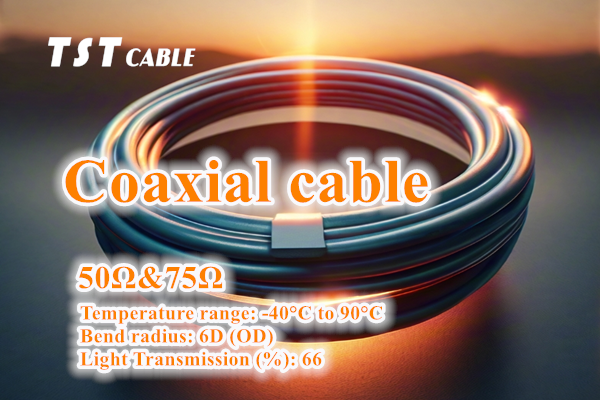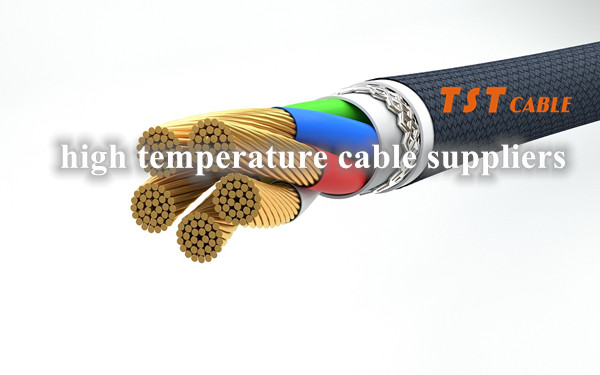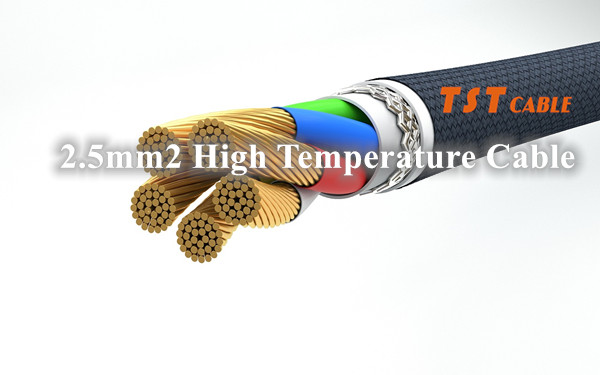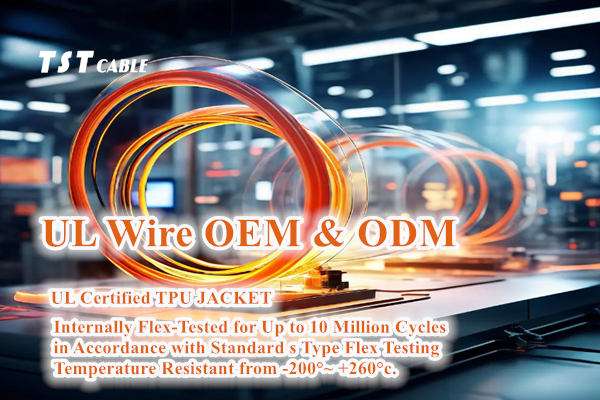
Introduces coaxial cable (50Ω/75Ω) structure, history, principle of operation, selection advice, application guide and other information.
Introduction to Coaxial Cable
Coaxial cable is a wire and signal transmission line, generally caused by four layers of material: the innermost is a conductive copper wire, the outside of the line there is a layer of plastic (as an insulator, dielectric with) surrounded by a layer of insulators and a thin layer of mesh outside the conductor (generally copper or alloy), and then the conductor outside the outermost insulating material as a sheath.
Coaxial cable can be used for the transmission of analog and digital signals for a variety of applications, the most important of which are cable television transmission, long-distance telephone transmission, short-distance connection between computer systems and local area networks. Coaxial cables are developing rapidly as a means of distributing television signals to millions of homes, which is cable television. A cable TV system can be loaded with dozens or even hundreds of TV channels, and its transmission range can reach tens of kilometers. Coaxial cable has long been an important part of long-distance telephone networks. Today, it faces increasing competition from fiber optics, terrestrial microwave and satellite.
Coaxial cable, is a type of cable consisting of a conductor inside a conductive shield surrounded by a concentric, with a dielectric (insulating material) made of two separate materials; many coaxial cables also have a protective jacket or sheath. The term “coaxial” refers to the shared geometric axis of the inner conductor and outer shield.
Coaxial Cable Components
A coaxial cable consists of three parts: a center conductor, a layer of dielectric material and a shield. The center conductor is located in the middle of the coaxial cable, which can be solid or stranded. Surrounding the center conductor is the dielectric layer, which acts as a sort of buffer and fixes the center conductor. Outside the dielectric layer is the coaxial cable’s shield, which is usually copper foil, aluminum foil, woven mesh, or a combination of these. The shield is then separated from the environment by something like polyvinyl chloride (PVC).
Components
Core Conductor: Usually a single solid copper or copper-clad steel wire used to carry electrical signals. In some high-performance cables, multiple strands of fine wire may be used to minimize signal loss.
Insulation (Dielectric Insulation): a layer of insulating material around the center conductor, commonly used polyethylene (PE), polytetrafluoroethylene (PTFE) and so on. The material and thickness of the insulation layer will affect the electrical characteristics of the cable, such as signal attenuation and propagation speed.
Shielding: Located outside the insulating layer, usually consisting of one or more layers of woven metal mesh or foil, sometimes coupled with a metalized plastic film to provide electromagnetic shielding, reduce external interference, and prevent signal leakage.
Outer Jacket: The outermost protective layer, usually made of polyvinyl chloride (PVC), polyethylene (PE), or other durable materials, provides physical protection against water, moisture, and chemicals, and increases the mechanical strength of the cable.
Coaxial Cable Working Principle
The operating principle of coaxial cables is based on the theory of electromagnetic fields, which are generated when electrical signals are transmitted across the center conductor. The shield, as part of the loop, forms a complete signal transmission path along with the center conductor, while shielding against external interference and preventing internal signal leakage. The presence of insulation maintains the correct spacing between the center conductor and the shield, controlling the capacitive and inductive effects of the signal, which in turn affects the quality of the signal transmission.
Coaxial Cable Models
RG-8,RG-9,RG-11 all with 50Ω impedance for thick cable Ethernet
RG-58, 50Ω impedance, for thin Ethernet cables
RG-59,RG-75 both with 75Ω impedance for TV system.
RG-62, 93Ω impedance for ARCnet and IBM 3270 networks.
Difference between 50Ω and 75Ω coaxial cables
The 50Ω and 75Ω of coaxial cables refer to the cable’s characteristic impedance, a key electrical parameter that determines the type of transmission application for which the cable is best suited and the device interface that matches it.
50Ω coaxial cables: typically used for data transmission and certain types of radio communications, such as base station connections, antenna feeders for wireless devices, and baseband signal transmission in computer networks. 50Ω cables are designed for lower signal loss and higher power handling for applications that require higher data rates and low signal distortion, such as Ethernet, Wi-Fi antenna feeders, etc. The cable is designed for use in a variety of applications, including data networks, wireless devices, and computer networks. In data networks, these cables are capable of supporting higher data rates, such as 10Mbps to higher speeds.
75Ω Coaxial Cables: Mainly used in cable television (CATV) systems, satellite television reception, closed-circuit television (CCTV), and some broadcast television applications. 75Ω cables are designed for broadband signal transmission and are capable of carrying a wide range of frequencies, which makes them ideally suited for transmitting video signals as they are better able to handle high-frequency signals and reduce signal distortion. These cables are common in video applications because they maintain signal integrity and color accuracy, ensuring high-quality image transmission.
When choosing 50Ω or 75Ω coaxial cables, ensure that the impedance of the cable is matched to the other components in the system (e.g., amplifiers, receivers, transmitters) in order to avoid signal reflections and energy loss, thus ensuring optimal signal transmission quality. Mismatched impedances can lead to increased signal attenuation, signal distortion, and decreased system efficiency.
Coaxial cable naming rules
The first part is in English letters, representing the cable code, core insulation material, sheath material and derived characteristics.
The second part with numbers, representing the cable’s characteristic impedance (Ω)
The third part is expressed in numbers, representing the outer diameter of the core wire insulation of the cable (mm)
The fourth part with a number, representing the cable structure serial number
U.S. military standard MIL-C-17F in the RG type coaxial cable naming rules:
RG-58A/U
RG high (RF) coaxial cable
58 No.
A Revision
U General Specifications
Coaxial Cable Classification
- According to the use of points
Baseband coaxial cables: Baseband commonly used cables with a shield made of copper in the form of a mesh, with a characteristic impedance of 50 (e.g., RG-8, RG-58, etc.)
Broadband coaxial cable: broadband coaxial cable commonly used in the cable’s shield is usually made of aluminum stamping, the characteristic impedance is 75 (such as RG-59, etc.)
- According to the diameter is too small points
Coarse coaxial cable: suitable for relatively large local networks, it is a long standard distance, high reliability. Since the installation does not need to cut the cable, so you can flexibly adjust the computer into the network location as needed. However, the coarse cable network must be installed transceiver and transceiver cable, installation is difficult, so the overall cost is high.
Fine coaxial cable: installation is relatively simple, low cost, but due to the installation process to cut the cable, the two ends must be installed on the basic network connector (BNC), and then connected to the two ends of the T-type connector, so when the joints are more prone to poor contact potential hazards, which is currently in operation by one of the most common failures of the Ethernet.
Coaxial Cable Applications
Coaxial cable is a transmission line used to transmit low-loss, high-frequency electrical signals. It is used in telephone trunk lines, broadband Internet cables, high-speed computer data buses, cable television signals, and applications that connect radio transmitters and receivers to antennas. It differs from other shielded cables in that the cable and connector dimensions are controlled to provide the precise, constant conductor spacing necessary for its effective use as a transmission line.
Coaxial cable is used as a transmission line for radio frequency signals. Its applications include feeders that connect radio transmitters and receivers to antennas, computer network (e.g., Ethernet) connections, digital audio (S/PDIF), and distribution of cable television signals. One advantage of coaxial cable over other types of radio transmission lines is that in an ideal coaxial cable, the electromagnetic fields that carry the signal exist only in the space between the inner and outer conductors. This allows coaxial cable alignments to be installed next to metal objects without the power loss that occurs in other types of transmission lines. Coaxial cable also protects signals from external electromagnetic interference.
Coaxial Cable Connectors
The ends of coaxial cables are usually terminated with connectors. Coaxial connectors are designed to remain coaxial throughout the connection and have the same impedance as the connecting cable. The connectors are usually plated with a highly conductive metal such as silver or rust-resistant gold. Due to the skin effect, RF signals are transmitted at higher frequencies only by the plating and do not penetrate the connector body. However, silver loses its luster quickly and the resulting silver sulfide is poorly conductive, which degrades connector performance, making silver a poor choice for this application.
Coaxial Cable History
- 1880 – Oliver Hevesse patented the coaxial cable in England (Patent No. 1,407).
- 1884 – Werner von Siemens patents coaxial cable in Germany.
- 1941 – In the United States, AT&T laid the first commercial coaxial cable. It was connected from Minneapolis, Minnesota to Steamboat-Poynter, Wisconsin. The L1 system it used was capable of holding one television band or 480 telephone lines.
4.1956 – The world’s first transatlantic coaxial cable, TAT-1 (Transatlantic No. 1), is laid.
Types of coaxial cables
Between the inner and outer conductors according to the insulation medium is mainly divided into:
Foam-insulated cables: where the insulator of foam-insulated cables is made of physically foamed polyethylene material; foam-insulated cables are generally used in the telecommunication industry.
In the foam insulated RF coaxial cable, and according to the nature of transmission is divided into transmission cable and leakage cable (LCX, Leaky Coaxial cable) two kinds.
Air-insulated cable: air insulation refers to the insulating medium between the inner and outer conductors is air, the inner conductor is dependent on the outer conductor and an insulating solid medium between the spiral support. Air-insulated cables are generally used for a variety of high-power RF transmission.
According to the shape of the outer conductor, coaxial cable is further divided into:
Corrugated coaxial cables. Generally, corrugated cables have better flexibility and reliability, and better bending radius performance compared to straight walls. Therefore, the industry mainly uses the bellows outer conductor coaxial cable.
Straight wall coaxial cable. According to the different materials of the outer conductor, the current transmission cable is mainly divided into two categories: copper feeder and aluminum feeder. Aluminum cable because of its relative to the international price fluctuations of copper and its own price fluctuation is relatively small, so it has a better cost advantage. Since the inner conductor of aluminum cable still uses copper as the propagation medium, its electrical performance is comparable to that of copper outer conductor cables, and operators are slowly accepting this new feeder category.
Coaxial cable and non-coaxial cable difference
- Different composition materials
Coaxial cable: the composition of the material is insulating material isolated copper conductor. Non-coaxial cable: the composition of the material is several or several groups of wires.
- Different classifications
Coaxial cable: divided into baseband coaxial cable and broadband coaxial cable. Coaxial cable: DC cable and AC cable.
- Different types
Coaxial cable: divided into thin cable RG-58 and thick cable RG-11. non-coaxial cable: divided into flame-retardant rubber cables, nuclear-grade cables, * wire and * conductor products, power cables, communication cables and optical fibers, electromagnetic wires (winding wire), sex fire cable.
Performance parameters and selection of coaxial cable
When selecting the right coaxial cable, you need to focus on the following key performance parameters to ensure that it meets the needs of a particular application:
Signal attenuation (Attenuation): The loss of energy when a signal is transmitted along a cable, usually in dB/100 meters or dB/1000 feet. Attenuation increases with frequency and is also affected by cable length, insulation material and cable diameter. The selection of low attenuation cables is critical for long distance transmission or high frequency applications.
Shielding Effectiveness: A measure of a cable’s ability to resist external electromagnetic interference (EMI) and prevent internal signal leakage. Good shielding can reduce signal distortion and improve the stability of data transmission. Double or triple shielded cables usually provide better shielding.
Characteristic Impedance: Ideally, coaxial cables should have a constant impedance, usually 50Ω or 75Ω, matching the impedance of the transmission line and the receiving equipment to minimize reflections and signal distortion. Different applications have their own recommended impedance values, e.g. 50Ω is commonly used for data communications and 75Ω for video transmission.
Voltage Standing Wave Ratio (VSWR): An indicator reflecting the efficiency of signal transmission, the ideal value is 1, the closer to 1 the better in practice, indicating that the signal reflection is small and the transmission efficiency is high.
Frequency Range: The frequency range in which the cable can effectively transmit signals. Wideband coaxial cables can cover a wider range of frequencies and are suitable for transmitting a variety of frequency signals, such as television and data communications.
Mechanical Strength and Flexibility: Depending on the installation environment, cables may be required to have a certain level of tensile strength, flexural properties or abrasion resistance. Outdoor installations usually require a more robust outer jacket.
Coaxial Cable Installation and Maintenance Precautions
Correct grounding: Ensure that the shield is well grounded, which can effectively prevent electromagnetic interference and protect equipment safety.
Avoid excessive bending: Excessive bending will increase signal attenuation, especially near the ends of the cable, and a proper bend radius should be maintained.
Waterproof sealing: For outdoor or moisture-prone installation environments, waterproof connectors and sealing tape should be used to prevent moisture intrusion.
Periodic Inspection and Cleaning: Periodically inspect cables and connectors for physical damage, corrosion, or looseness to maintain good contact.
Signal Testing: Perform signal quality tests after installation and during regular maintenance to ensure transmission performance meets expectations.
TST CABLES – Leading Global Coaxial Cable Supplier
Coaxial cable supplier TST CABLES reminds you that the selection and use of coaxial cables involves a number of considerations, and that understanding their basic structure, performance parameters and their requirements in different application scenarios is the key to ensuring the quality of communication and system stability.
TST CABLES coaxial cable with ultra-low signal attenuation and excellent anti-external electromagnetic interference (EMI) shielding performance, we make every bit of data jump in the invisible, across the distance of time and space, directly to the heart. From the delicate transmission of high-definition images to the smooth experience of high-speed networks, coaxial cables, with their precise 50Ω/75Ω impedance, ensure that the excitement of each moment is not compromised. Whether it’s the immersive enjoyment of a home theater or the robust support of a wide-area network, we are your trusted information bridge. If you have needs or questions about coaxial cables, you can send us an email, senior engineers are happy to serve you, you can also receive free samples.
Also available in:
English





